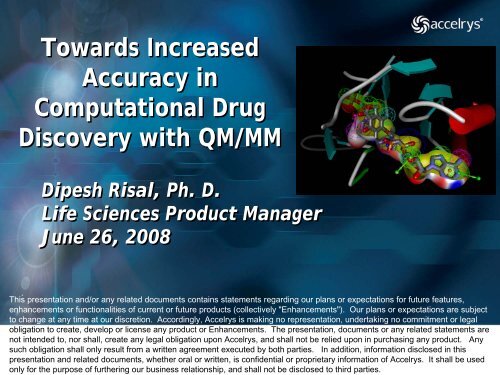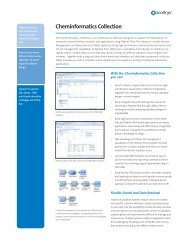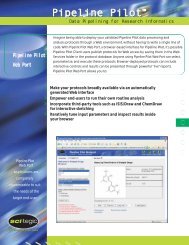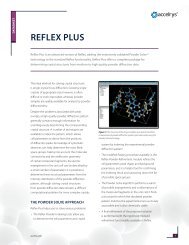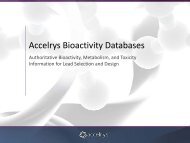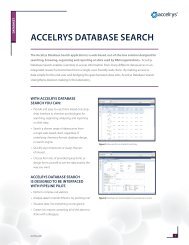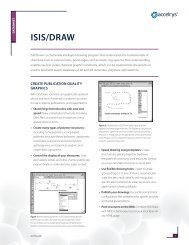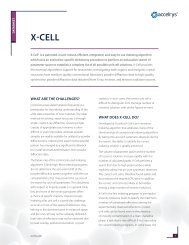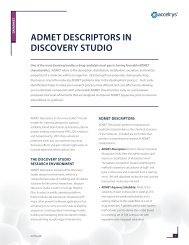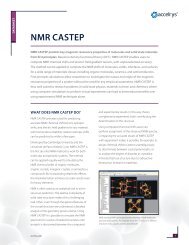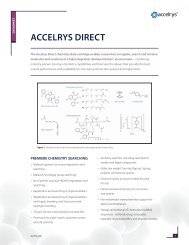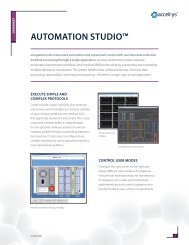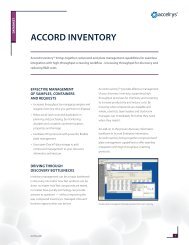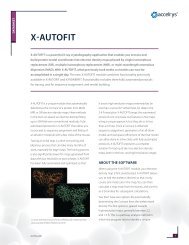QM - Accelrys
QM - Accelrys
QM - Accelrys
You also want an ePaper? Increase the reach of your titles
YUMPU automatically turns print PDFs into web optimized ePapers that Google loves.
Towards Increased<br />
Accuracy in<br />
Computational Drug<br />
Discovery with <strong>QM</strong>/MM<br />
Dipesh Risal, Ph. D.<br />
Life Sciences Product Manager<br />
June 26, 2008<br />
This presentation and/or any related documents contains statements regarding our plans or expectations for future features,<br />
enhancements or functionalities of current or future products (collectively "Enhancements"). Our plans or expectations are subject<br />
to change at any time at our discretion. Accordingly, <strong>Accelrys</strong> is making no representation, undertaking no commitment or legal<br />
obligation to create, develop or license any product or Enhancements. The presentation, documents or any related statements are<br />
not intended to, nor shall, create any legal obligation upon <strong>Accelrys</strong>, and shall not be relied upon in purchasing any product. Any<br />
such obligation shall only result from a written agreement executed by both parties. In addition, information disclosed in this<br />
presentation and related documents, whether oral or written, is confidential or proprietary information of <strong>Accelrys</strong>. It shall be used<br />
only for the purpose of furthering our business relationship, and shall not be disclosed to third parties.
Overview<br />
• <strong>QM</strong>/MM background<br />
• <strong>QM</strong>/MM implementation<br />
• Validation: Scientific applications of <strong>QM</strong>/MM<br />
© 2007 <strong>Accelrys</strong>, Inc.<br />
2
<strong>QM</strong>/MM overview<br />
• Combine <strong>QM</strong> and MM methods<br />
to achieve good accuracy at<br />
low cost<br />
– Treat ‘chemically<br />
significant’ region with <strong>QM</strong><br />
– Treat the bulk with MM<br />
– Combine the results<br />
© 2007 <strong>Accelrys</strong>, Inc.<br />
MM region<br />
<strong>QM</strong> region<br />
Ligand<br />
3
<strong>QM</strong>/MM in Discovery Studio<br />
• A <strong>QM</strong>/MM method has been<br />
implemented that<br />
incorporates<br />
– DMol3 (DFT) for the <strong>QM</strong><br />
region<br />
– CHARMm for the MM region<br />
– QUANTUMm, a<br />
communication program<br />
between the two regions<br />
• How do each of these<br />
programs work?<br />
© 2007 <strong>Accelrys</strong>, Inc.<br />
MM region<br />
<strong>QM</strong> region<br />
Ligand<br />
4
<strong>QM</strong>/MM Overview<br />
Anatomy of <strong>QM</strong>/MM machinery<br />
© 2007 <strong>Accelrys</strong>, Inc.<br />
xyz<br />
<strong>QM</strong><br />
Engine<br />
E<br />
∇E<br />
q<br />
<strong>QM</strong>/MM<br />
Driver<br />
xyz<br />
q<br />
MM<br />
Engine<br />
E<br />
∇E<br />
<strong>QM</strong>/MM<br />
Driver<br />
Call <strong>QM</strong> Call MM<br />
<strong>QM</strong>/MM<br />
Driver<br />
Geometry<br />
optimization or<br />
MD step<br />
Repeat<br />
• <strong>QM</strong> and MM servers only provide energies and gradients<br />
• Propagation algorithms (geometry optimization, MD, TS search ...)<br />
operate on data received from compute engines<br />
5
DMol3 DMol Overview<br />
3 Overview<br />
• DMol 3 uses DFT to predict structures, energies,<br />
electronic properties<br />
• Works for molecular and periodic systems<br />
• Extremely fast<br />
– Numerical basis sets provide a rapid means of evaluating<br />
Coulomb and exchange-correlation potentials<br />
– Provides options to trade off between computational cost<br />
and accuracy<br />
• Delley, J. Chem. Phys.113, 7756 (2000)<br />
– Energy calculations on drug-size molecules require few<br />
minutes on typical laptop<br />
© 2007 <strong>Accelrys</strong>, Inc.<br />
6
DMol3 DMol Functionals<br />
3 Functionals<br />
© 2007 <strong>Accelrys</strong>, Inc.<br />
H-bonded complexes Dispersion-dominated<br />
complexes<br />
Type of<br />
complex DMol 3 /PBE DMol 3 /HCTH Z-T B3LYP 1 Z-T PBE 1<br />
H-bond 1.0 3.4 2.0 1.3<br />
Dispersion 3.2 2.8 6.5 4.9<br />
Mixed 1.2 0.9 2.9 1.9<br />
1. J. Chem. Theory Comput. (2007), 3, 289-300.<br />
Mixed<br />
complexes<br />
Avg. Error (kcal/mol)<br />
of binding energies<br />
in loose complexes<br />
7
MM engine: CHARMm<br />
• CHARMm: the industry standard for simulation of macromolecules and protein-ligand systems<br />
• Constant Forcefield development<br />
– Alex MacKerell, Charlie Brooks, Bernard Brooks, <strong>Accelrys</strong>, Others<br />
• Most comprehensive simulation package available<br />
– MM, MD<br />
– CDOCKER<br />
– Free Energy Perturbation (FEP)<br />
– MM-PB/GB SA Scoring<br />
– Normal Mode analysis<br />
– RDOCK (refinement of Protein-Protein docking)<br />
– ChiRotor, Looper<br />
– Replica Exchange Molecular Dynamics (REMD)<br />
– Three implicit membrane models<br />
• GBSW, GBSA-IM, IMM1<br />
– Umbrella sampling<br />
– Monte Carol simulations<br />
– Physics-based pK Prediction and Protein Ionization<br />
– Constant-pH MD<br />
– And many more!<br />
• Strong UI support in Discovery Studio<br />
– Antibody Modeling<br />
– Implicit Membrane Modeling<br />
– Receptor-Flexible Docking<br />
© 2007 <strong>Accelrys</strong>, Inc.<br />
8
QUANTUMm Overview<br />
• Total energy ...<br />
Etotal MM<br />
<strong>QM</strong> <strong>QM</strong> MM<br />
• Scientific requirements for biological<br />
<strong>QM</strong>/MM:<br />
– <strong>QM</strong> region “feels” MM atom<br />
environment<br />
– Minimal number of FF parameters<br />
for <strong>QM</strong> region<br />
• Issues to address<br />
– Embedding: how does the <strong>QM</strong> region<br />
interact with the MM region?<br />
– Boundary region: what happens to<br />
bonds that cross between regions?<br />
© 2007 <strong>Accelrys</strong>, Inc.<br />
( O,<br />
I)<br />
=<br />
E ( O)<br />
+ E ( I)<br />
+ E / ( O ↔ I)<br />
E total = E(<br />
RMM,<br />
R<strong>QM</strong>)<br />
9
<strong>QM</strong> ↔ MM Coupling: Electrostatics<br />
<strong>QM</strong> density is polarized by MM point charges:<br />
electronic embedding<br />
© 2007 <strong>Accelrys</strong>, Inc.<br />
MM → <strong>QM</strong><br />
<strong>QM</strong> → MM<br />
elec<br />
E <strong>QM</strong> /<br />
MM<br />
O charges polarize I density<br />
I gradients induce forces on O<br />
Part of <strong>QM</strong> energy expression<br />
10
QUANTUMm Issue: Broken <strong>QM</strong> ↔ MM bonds<br />
© 2007 <strong>Accelrys</strong>, Inc.<br />
Problem: <strong>QM</strong> calculation on I region yields unrealistic species<br />
→ add link atom (L) to <strong>QM</strong> calculation<br />
• Link atom is absent in MM calculation<br />
• Position restrained onto C A -C B vector<br />
• <strong>QM</strong>/MM server program handles link atoms transparently<br />
[Field, JCC 1990]<br />
11
Complications: Electrostatics<br />
Electronic embedding and link atoms<br />
Problem: <strong>QM</strong> overpolarization near link atoms: MM host too close<br />
Solution: the <strong>QM</strong> fragment should see no charge from MM host atom<br />
© 2007 <strong>Accelrys</strong>, Inc.<br />
[Bakowies, JPC 1996; Sinclair, J Chem Soc Faraday 1998]<br />
12
QUANTUMm User Interface<br />
• DS QUANTUMm allows easy job setup<br />
• Select <strong>QM</strong> region<br />
• Set DFT options<br />
© 2007 <strong>Accelrys</strong>, Inc.<br />
– Charge on <strong>QM</strong> region<br />
– Spin multiplicity of <strong>QM</strong> region<br />
– Relative precision (basis set, integration grid, SCF<br />
convergence)<br />
• Number of processors for parallel calculation<br />
• Provides the tools you need to balance the size of the<br />
problem, relative accuracy, and computational cost<br />
13
<strong>QM</strong>/MM Implementation I<br />
• Methods available for first release<br />
© 2007 <strong>Accelrys</strong>, Inc.<br />
– <strong>QM</strong>/MM Minimization<br />
– <strong>QM</strong>/MM Energy Calculation (Single Point Energy)<br />
• If only the ligand is in the <strong>QM</strong> region, both protocols output<br />
ESP, Hirshfeld and Mulliken charges for ligand<br />
– Recharge Ligand Pipeline Pilot Component<br />
• Point charges from a protein model used in the electronic<br />
structure calculation, causing polarization of the ligand<br />
14
<strong>QM</strong>/MM Calculation: Setup in Discovery Studio<br />
© 2007 <strong>Accelrys</strong>, Inc.<br />
15
<strong>QM</strong>/MM Applications for Life Science<br />
• <strong>QM</strong>/MM-derived ligand partial charges for:<br />
– improved docking accuracy (and simulation)<br />
• Optimization of hydrogen bonds<br />
– Post-processing of docked poses<br />
• Modeling of special electrostatic interactions not fully captured<br />
by force fields<br />
– Cation-Pi interactions<br />
– Pi-Pi interactions<br />
– Charge transfer<br />
– Metal-ligand-protein interactions<br />
• Improved estimate of interaction energy between protein and<br />
ligand<br />
• <strong>QM</strong>/MM in conjunction with MD 1 , <strong>QM</strong>-PBSA 2<br />
• Preparing ligands and cofactors for MM calculations 3<br />
– Heme, others<br />
• Studying reaction mechanisms 3<br />
– individual steps (hydrolysis, etc.)<br />
– transition state<br />
– entire catalytic cycle<br />
• Activation free energy 3<br />
• <strong>QM</strong>/MD (dynamics)<br />
• Semi-empirical method in <strong>QM</strong>/MM<br />
© 2007 <strong>Accelrys</strong>, Inc.<br />
Possible Today. Some validation<br />
Already available<br />
Possible Today. Validation<br />
ongoing<br />
Possible in future releases based<br />
on customer prioritization<br />
1. J Comput Aided Mol Des. 2007 Jan-Mar;21(1-3):131-7<br />
2. J Phys Chem B, 109 (2):10474-83.<br />
3. Chem Rev. 2006 Sep;106(9):3497-519<br />
4. Drug Discov Today: Technologies, 2004 Dec; 1(3), 253-260<br />
5. Drug Discov Today. 2007 Sep;12(17-18):725-31 .<br />
16
<strong>QM</strong>/MM Background: Partial Charge Analysis<br />
Partial charges on ligand after MM and <strong>QM</strong>/MM Minimization, 1STP-1: Streptavidin/Biotin<br />
0.8<br />
0.6<br />
0.4<br />
0.2<br />
-0.2<br />
-0.4<br />
-0.6<br />
-0.8<br />
© 2007 <strong>Accelrys</strong>, Inc.<br />
0<br />
MM Min <strong>QM</strong>/MM Min<br />
C11<br />
O11<br />
O12<br />
C10<br />
C9<br />
C8<br />
C7<br />
C2<br />
S1<br />
C6<br />
C5<br />
N1<br />
C3<br />
O3<br />
N2<br />
C4<br />
H1<br />
H2<br />
H3<br />
H4<br />
Generally, H-bond donors become increase in δ+<br />
H-bond acceptors increase in δ-<br />
CHA RMm M-Rone<br />
CFF<br />
<strong>QM</strong>/MM Min<br />
H5<br />
H6<br />
H7<br />
H8<br />
H9<br />
H10<br />
H11<br />
H12<br />
H13<br />
H14<br />
H15<br />
H16<br />
17
<strong>QM</strong>/MM Applications: Background<br />
• CDOCKER is a CHARMm-based small molecule docking refinement<br />
algorithm 1<br />
© 2007 <strong>Accelrys</strong>, Inc.<br />
– Uses soft-core potentials<br />
– Grid-based (optional)<br />
Generate ligand conformations<br />
through high temperature MD<br />
Random (rigid-body) rotation<br />
(grid-based) simulated annealing<br />
Full minimization<br />
Output # of refined ligand poses<br />
sorted by energy<br />
(vdW+ e/s + ligand strain)<br />
1. Wu et al. J Comput Chem (2003) 24:1549-62<br />
18
<strong>QM</strong>/MM Applications: Improving Docking Accuracy*<br />
• CDOCKER on AstexDiverse Dataset** (85<br />
diverse, high-resolution protein-ligand<br />
complexes)<br />
Prepared X-ray<br />
Protein- Ligand<br />
Complex<br />
Calculate CDOCKER <strong>QM</strong> charges<br />
for ligand<br />
© 2007 <strong>Accelrys</strong>, Inc.<br />
Randomize<br />
Ligand Conformation<br />
Top<br />
Pose<br />
Dock with<br />
CDOCKER<br />
CDOCKER<br />
Dock with<br />
CDOCKER<br />
CDOCKER-<br />
<strong>QM</strong>-CDOCKER<br />
* Cho et al, J Comput Chem 26: 915–931, 2005<br />
** Hartshorn et al. JMC 2007<br />
Top<br />
Pose<br />
Top<br />
Pose<br />
Calculate RMSD<br />
to X-ray<br />
Calculate RMSD<br />
to X-ray<br />
Success<br />
Avg.<br />
RMSD<br />
Success<br />
Avg.<br />
RMSD<br />
First<br />
Pose<br />
72.62% 73% 72.62% 73%<br />
1.6331 1.6 1.6331 1.6<br />
First<br />
Pose<br />
77.38% 79%<br />
1.3856 1.4<br />
Poses are scored with CDOCKER Energy:<br />
sum of electrostatics+vdW interaction energy + ligand strain E<br />
X-Ray (A)<br />
Best<br />
Pose<br />
88.10% 88% 88.10% 88%<br />
1.0289 1.0 1.0289 1.0<br />
X-Ray (B)<br />
Best<br />
Pose<br />
90.48% 88%<br />
0.9114 1.3<br />
19
<strong>QM</strong>/MM Applications: Improving Docking Accuracy<br />
•<br />
• Pipeline Pilot workflow for CDOCKER-<strong>QM</strong>-CDOCKER<br />
© 2007 <strong>Accelrys</strong>, Inc.<br />
Available options:<br />
ESP, Hirshfeld, Mulliken<br />
Available Options:<br />
Coarse/Medium/Fine.<br />
Affects the basis set, k-point,<br />
and SCF convergence criteria<br />
Available Options: local<br />
(LDA) potentials (PWC,<br />
VWN) and gradientcorrected<br />
(GGA) potentials<br />
(PW91, BP, PBE, BLYP, BOP,<br />
VWN-BP, RPBE, HCTH).<br />
20
<strong>QM</strong>/MM Applications: Improving Docking Accuracy<br />
• CDOCKER-<strong>QM</strong>-CDOCKER on AstexDiverse dataset:<br />
success by RMSD bin<br />
100%<br />
90%<br />
80%<br />
70%<br />
60%<br />
50%<br />
40%<br />
30%<br />
20%<br />
10%<br />
0%<br />
© 2007 <strong>Accelrys</strong>, Inc.<br />
< 0.5 Å < 1.0 Å < 1.5 Å < 2.0 Å<br />
Only single, top-ranked<br />
pose for each PDB complex considered<br />
CDOCKER First Pose<br />
<strong>QM</strong>-CDOCKER First Pose<br />
100%<br />
90%<br />
80%<br />
70%<br />
60%<br />
50%<br />
40%<br />
30%<br />
20%<br />
10%<br />
0%<br />
CDOCKER Best Pose<br />
<strong>QM</strong>-CDOCKER Best<br />
< 0.5 Å < 1.0 Å < 1.5 Å < 2.0 Å<br />
Best-RMSD pose (to X-ray)<br />
out of 10 docked poses considered<br />
21
<strong>QM</strong>/MM Application: Cation-Pi Interaction Modeling<br />
• Investigate the binding of Compound 1(active<br />
against Histamine H3 receptor) on AChE 1<br />
• Goal was to design dual-acting compound<br />
• Hypothesis of two cation-pi interactions<br />
between ligand and receptor<br />
• Docking (CDOCKER) of Compound 1 into AChE<br />
receptor (PDB ID 1EVE) yielded a pose in<br />
position to make cation-Pi interactions<br />
• Cation-Pi not modeled well by force fields<br />
• <strong>QM</strong>/MM geometry optimization suggests<br />
cation-Pi interactions<br />
– 51 hrs on 2 processors<br />
– Multiplicity: Smart<br />
– Quality: Ultra Coarse<br />
– Infinite nonbonded cutoffs<br />
– No constraints/restraints<br />
© 2007 <strong>Accelrys</strong>, Inc.<br />
Einitial = -15676.278608 kcal/mol<br />
Efinal = -16904.454283 kcal/mol<br />
1. Bembenek, S. D.. et al., Bioorg. Med Chem. (2008),<br />
22
<strong>QM</strong>/MM Application: Optimizing Heme systems<br />
• Starting Structure: PDB ID 1P2Y 1 , Cytochrome P450CAM<br />
in complex with (S)-(-)-Nicotine<br />
nicotine<br />
Cys 357<br />
© 2007 <strong>Accelrys</strong>, Inc.<br />
Arg 112<br />
His 355<br />
1. Biochemistry 42: 11943-11950<br />
Arg 299<br />
<strong>QM</strong>/MM min.<br />
2 proc. 2.6 GHz<br />
Xeon ca. 4 days<br />
nicotine<br />
Cys 357<br />
Arg 112<br />
His 355<br />
• improved coordination between Arg and<br />
heme carboxyl groups<br />
• coordination of Fe (II)<br />
Arg 299<br />
23
<strong>QM</strong>/MM Application: Optimizing Heme systems<br />
• Starting Structure: PDB ID 1P2Y 1 , Cytochrome P450CAM<br />
in complex with (S)-(-)-Nicotine<br />
6-coordination of Zinc in <strong>QM</strong>/MM optimized structure<br />
No constraints/restraints were used in the <strong>QM</strong>/MM optimization experiment<br />
© 2007 <strong>Accelrys</strong>, Inc.<br />
1. Biochemistry 42: 11943-11950<br />
Initial QUANTUMm Energy = -29288.570302 kcal/mol<br />
Initial <strong>QM</strong> Energy = -13252.109685 kcal/mol<br />
Initial MM Energy = -16036.460617 kcal/mol<br />
QUANTUMm Energy = -33719.154699 kcal/mol<br />
<strong>QM</strong> Energy = -14279.192571 kcal/mol<br />
MM Energy = -19439.962129 kcal/mol<br />
24
<strong>QM</strong>/MM Application: Modeling Metals in Proteins<br />
© 2007 <strong>Accelrys</strong>, Inc.<br />
Zinc Metalloproteins: important drug targets<br />
ligand bound to zinc ion<br />
development of zinc force field difficult<br />
coordination pattern<br />
electrostatics<br />
vdW interactions<br />
<strong>QM</strong>/MM description challenging<br />
large <strong>QM</strong> zone<br />
<strong>QM</strong>/MM bonds<br />
From Jain et al , PROTEINS 2007<br />
25
<strong>QM</strong>/MM Application: Optimization of MMP Binding Sites<br />
• Previous study 1 describes design and docking studies with matrix<br />
metalloproteinase-9 (MMP-9) and a set of hydroxamate inhibitors<br />
• The study was replicated in Discovery Studio 2.1<br />
– Sketch “Compound 1”<br />
– Dock to MMP9 receptor (PDB ID 1GKC) with CDOCKER<br />
© 2007 <strong>Accelrys</strong>, Inc.<br />
Top docked pose using CDOCKER<br />
1. J. Med. Chem, 2005, 48, 5437-5447<br />
2. J. Med. Chem. 2002, 45, 919-929<br />
Known hydroxamate interactions in MMP-9<br />
binding site 2<br />
26
<strong>QM</strong>/MM Application: Optimization of MMP Binding Sites<br />
• Previous study 1 describes design and docking studies with matrix<br />
metalloproteinase-9 (MMP-9) and a set of hydroxamate inhibitors<br />
• The study was replicated in Discovery Studio 2.1<br />
– Sketch “Compound 1”<br />
– Dock to MMP9 receptor (PDB ID 1GKC)<br />
– Take First Pose, optimize protein-ligand complex with <strong>QM</strong>/MM<br />
© 2007 <strong>Accelrys</strong>, Inc.<br />
1. J. Med. Chem, 2005, 48, 5437-5447<br />
2. J. Med. Chem. 2002, 45, 919-929<br />
27
<strong>QM</strong>/MM Application: Optimization of MMP Binding Sites<br />
• Some details of <strong>QM</strong>/MM experiment<br />
– 3 His, Zinc, Glu402, Ligand included in <strong>QM</strong> region<br />
– Cut between <strong>QM</strong> and MM region made at the CA-CB bond of residue<br />
side chains<br />
– 5Å shell around <strong>QM</strong> region subjected to MM (CHARMm)<br />
– Rest of the system kept frozen (as per published study 1 )<br />
– 2000 steps of minimization, PBE Functional, Ultra-Coarse setting<br />
(Basis Set: minimal, Integration Grid: xcoarse, DMol3 Cutoff 3.0 Å,<br />
SCF Density Convergence 5.0e-4)<br />
– 7 hours on 4 CPU 1.8GHz Opteron machine<br />
© 2007 <strong>Accelrys</strong>, Inc.<br />
1. J. Med. Chem, 2005, 48, 5437-5447<br />
28
<strong>QM</strong>/MM Application: Optimization of MMP Binding Sites<br />
• Previous study 1 describes design and docking studies with matrix<br />
metalloproteinase-9 (MMP-9) and a set of hydroxamate inhibitors<br />
• The study was replicated in Discovery Studio 2.1<br />
– Sketch “Compound 1”<br />
– Dock to MMP9 receptor (PDB ID 1GKC)<br />
– Take First Pose, optimize protein-ligand complex with <strong>QM</strong>/MM<br />
His411<br />
© 2007 <strong>Accelrys</strong>, Inc.<br />
Zn<br />
Before <strong>QM</strong>/MM (Docked Pose)<br />
His405<br />
1. J. Med. Chem, 2005, 48, 5437-5447<br />
2. J. Med. Chem. 2002, 45, 919-929<br />
Glu402<br />
His401 Zn<br />
His411<br />
After <strong>QM</strong>/MM<br />
His405<br />
Glu402<br />
His401<br />
29
<strong>QM</strong>/MM Application: Optimization of MMP Binding Sites<br />
• Previous study 1 describes design and docking studies with matrix<br />
metalloproteinase-9 (MMP-9) and a set of hydroxamate inhibitors<br />
• The study was replicated in Discovery Studio 2.1<br />
– Sketch “Compound 1”<br />
– Dock to MMP9 receptor (PDB ID 1GKC)<br />
– Take First Pose, optimize protein-ligand complex with <strong>QM</strong>/MM<br />
His411<br />
© 2007 <strong>Accelrys</strong>, Inc.<br />
Zn<br />
His405<br />
1. J. Med. Chem, 2005, 48, 5437-5447<br />
2. J. Med. Chem. 2002, 45, 919-929<br />
Glu402<br />
His401<br />
<strong>QM</strong>/MM optimized distances and partial charges in a<br />
hydroxamate-MMP9 complex from a published study 1<br />
30
<strong>QM</strong>/MM Application: Optimization of MMP Binding Sites<br />
• Comparison of post-optimized interactions of two MMP-9 actives<br />
– Ongoing work: <strong>QM</strong>/MM-based scoring and rank-ordering of actives in the series 1,2<br />
© 2007 <strong>Accelrys</strong>, Inc.<br />
His411<br />
“Compound 1”<br />
K i = 5.05 nM<br />
<strong>QM</strong>/MM Inter E =<br />
-246.95 Kcal/mol<br />
Zn<br />
His405<br />
1. J. Med. Chem, 2005, 48, 5437-5447<br />
2. J. Med. Chem. 2002, 45, 919-929<br />
Glu402<br />
His401<br />
His411<br />
“Compound 20”<br />
K i = 0.08 nM<br />
<strong>QM</strong>/MM Inter E =<br />
-266.92 Kcal/mol<br />
Zn<br />
Glu402<br />
His401<br />
<strong>QM</strong>/MM optimized distances and partial charges in a<br />
hydroxamate-MMP9 complex from a published study1 <strong>QM</strong>/MM optimized distances and partial charges in a<br />
hydroxamate-MMP9 complex from a published study<br />
His405<br />
1<br />
His405<br />
31
Summary/ Future Plans<br />
• <strong>QM</strong>/MM methods have been shown to provide improvement over<br />
pure force field (CHARMm) calculations<br />
• <strong>QM</strong>/MM methods have been applied in real-life computational tasks<br />
– Improved partial charges for docking<br />
– Modeling of special interactions such as cation-pi<br />
– Refinement of heme-containing systems<br />
– Optimization of metalloprotein active sites<br />
• accurate interaction energies<br />
• Ongoing validation<br />
– <strong>QM</strong>/MM-based scoring function<br />
– Comparison of DMol3 ESP charges with AM1-BCC, others<br />
– Torsion profiles (ΔE vs. torsional angle) for select small molecules<br />
• Future developments on <strong>QM</strong>/MM will be exclusively based on<br />
customer feedback<br />
– <strong>QM</strong>/MM based scoring function<br />
– Semi-empirical methods for <strong>QM</strong><br />
– Modeling reaction mechanisms<br />
© 2007 <strong>Accelrys</strong>, Inc.<br />
32
Thank you!!!<br />
• Thank You for attending today’s webinar. If you have any further questions please<br />
e-mail me at: drisal@accelrys.com<br />
• You can also contact us using the form on our website:<br />
http://accelrys.com/company/contact/<br />
• We will be exhibiting at the following upcoming events:<br />
© 2007 <strong>Accelrys</strong>, Inc.<br />
– CHI Protein Kinase Targets (June 23 – 25, Boston, Booth #4)<br />
– CHI Structure Based Design (June 25 – 27, Boston, Booth #7)<br />
– Drug Discovery Technology and Development (August 4 – 7, Boston, Booth #512)<br />
– ACS Fall 2008 (August 17 – 21, Philadelphia, Booth #211)<br />
• Reminder: the next webinar in this series will be:<br />
– Pharmacophore Guided Fragment-Based Drug Design<br />
Dr. Tien Luu – July 10, 2008 at 7am PST and 10am PST<br />
33
<strong>QM</strong> ↔ MM coupling: Short-range<br />
© 2007 <strong>Accelrys</strong>, Inc.<br />
•<strong>QM</strong> ↔ MM van-der-Waals<br />
interactions<br />
handled classically (i.e., by<br />
MM server)<br />
•Requires Lennard-Jones<br />
parameters for <strong>QM</strong> region<br />
34
HOMO/LUMO Visualization (Work in Progress…)<br />
© 2007 <strong>Accelrys</strong>, Inc.<br />
Diene Dienophile<br />
Diels-Alder Reaction<br />
The electron-rich HOMO of the diene and the<br />
Electron-vacant LUMO of the dienophile must<br />
be in a stacked orientation (top-bottom) for<br />
maximal overlap of the orbitals for the reaction<br />
to proceed<br />
HOMO LUMO<br />
35


